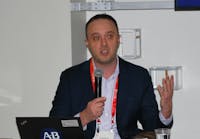Everything automated will one day incorporate AI
Artificial intelligence (AI) systems and agents aren’t poised to take over factory operations any time soon, but they’re already influencing every step pf the manufacturing process. “Every level of the automation stack needs AI,” said Jordan Reynolds, vice president of AI and autonomy at Rockwell Automation. “And, forget about the term AI. Every level of the automation stack needs learning features, adaptation functions, the ability to solve optimization problems, the ability to generate content and the ability to facilitate instructions. That’s fundamentally what we’re talking about.”
Speaking at the Automation Fair 2025 this week in Chicago, Reynolds said nearly every job within manufacturing will evolve throughout the next several years as AI takes over basic functions. How many years? Great question… the industry is still figuring that out.
Reynolds stressed, though, that change is coming to every level of the plant—from the shop floor through the C-suite.
“People are no longer focused on the tactical manipulation of parameters. You’re not going to see a lot of machinists standing in front of equipment manipulating knobs, changing temperature and pressure and speed parameters,” Reynolds said. “You’re going to see them monitoring the process and refining the goals.”
Rather than manipulating or monitoring one piece of equipment, line workers could monitor processes run across several machines or even have plantwide responsibilities.
The process designer, similarly, will move from a technical, tactical role to a more strategic position.
“The way that you program a PLC today, it’s what’s called the computationally intractable problem. You can never imagine all the variables or [how to operate] under every possible scenario,” Reynolds added.
Engineers will focus less on process parameters and more on goals—machine longevity vs. production levels, for example. AI-based systems will set the guidelines that meet those goals, under human supervision, rather than everything having to be manually derived.
He stressed that these are all long-term visions. It will take years, maybe decades for the industry to adapt to what’s possible, and there will likely be many failures along the way.
“What the PLC becomes is something like an adaptable learning controller,” Reynolds said. “Machine-learning-based control policies are natively integrated into the control system. And, the sensors and actuators in our portfolio essentially play the role of understanding the environment and then manipulating the environment on the basis of what the machine learning model says. This is fundamentally, what Rockwell Automation is going after.”
As the industry adapts to new and increasingly sophisticated AI tools, nearly every employee within manufacturing will need to re-evaluate what they bring to the table. Process know-how and institutional memory will remain important, but machines will begin offering a version of that, Reynolds said.
“The key knowledge asset in the past was your experience, your domain knowledge of the application, your first principles on understanding of how a production process works and that’s still as important as ever,” he said. “But there’s a new knowledge asset which is essentially high volumes of diverse data that serve as the training corpus for machine learning…. Fundamentally, that is the skill transition that that we’re undergoing right now – take all of the traditional industrial engineering domains, control theory, digital signal processing, electrical engineering, chemical engineering, things like that, things that people do on the plant floor and then add in kind of a new set of multi-disciplinary expertise around machine learning, AI and these new kind of capabilities.”
From automation to autonomy
During his presentation, Rockwell AI expert Jordan Reynolds spelled out how various plant functions will move from an automated environment to an AI-driven autonomous one.
|
Manufacturing Process Facing Transformation |
Automated (current tech) |
Autonomous (future tech) |
|
Design |
Explicit programming |
Learning system |
|
Operations |
Tactical manipulation of parameters |
Goal definition |
|
Breadth |
Single work cell or unit operation |
Line-level or area-level responsibilities |
|
Applications |
Low-dimentional, linear, stationary |
Multi-variable, nonlinear, dynamic |
|
Knowledge |
Domain knowledge, first principles |
High-volume, diverse data |
|
Skills |
Industrial Engineers |
AI users throughout the organization |
About the Author
Robert Schoenberger
Engineering Design and Automation Group
Robert Schoenberger is vice president of content strategy for the Engineering Design and Automation group of EndeavorB2B.
